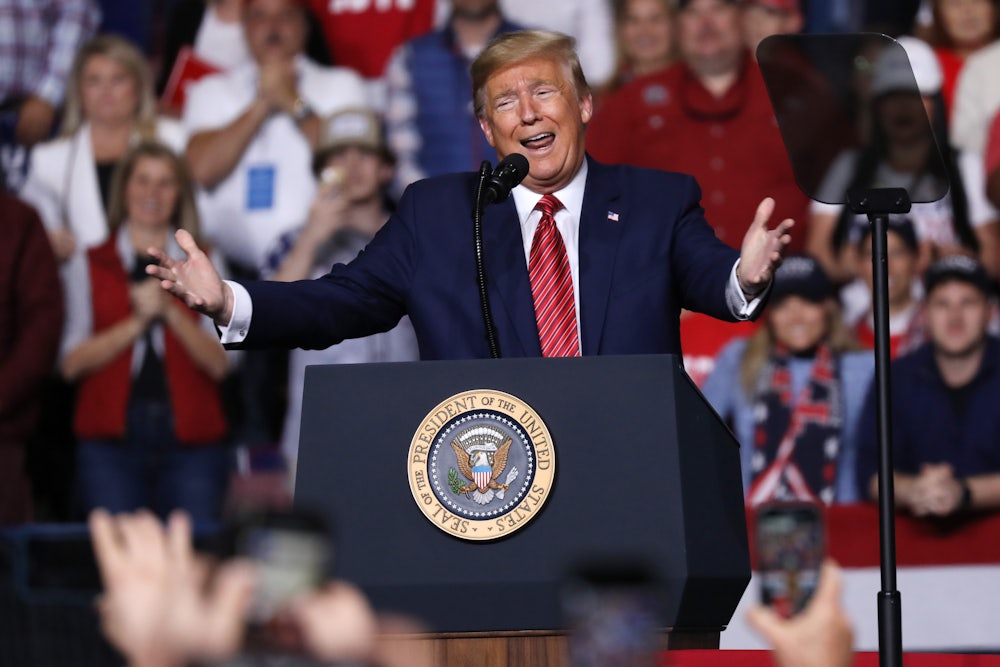There is a certain kind of sputtering disbelief that characterizes a lot of liberal reactions to Trump, for good reason. Even after four years of this routine, it can still seem unbelievable to watch him openly admit to many of the things he admits to and continue to get away with it; he takes the thing that’s supposed to be whispered in private and just tweets it out. Since the coronavirus pandemic has torn across America, this phenomenon has taken on an even more horrible tone. He makes proclamations that seem straight out of a political farce, such as his belief that the virus will “disappear” on its own or how in the meantime it’s a bad idea to increase testing for Covid-19 because that just makes the number of cases go up.
It’s hard to pinpoint exactly why this combination of foolhardiness and bravado works so well on his voters, but it does, and a grim new piece of evidence for this emerged in time for the quadrennial Republican National Convention: A new poll has found that 57 percent of Republicans believe the number of coronavirus deaths that have occurred in the United States is “acceptable.” You read that right. A majority of Republicans think the death toll from the coronavirus—currently at 177,000, though the true number may be more than 200,000—is just fine. It is surely related that the same poll showed 64 percent of Republican voters believe the true number of deaths to be lower than what’s being reported. They have heard their president sow doubt and dismissal about the coronavirus and responded accordingly.
It is hardly news if Republican voters believe something that is the opposite of reality. What is significant is that there is a disconnect between the scale of disaster currently happening in America with its accompanying loss of life and the response of huge, important groups of voters. How many deaths would it take for Republican voters to change their minds—or to not vote enthusiastically for Trump? (After a five-point dip in May, his approval rating with Republicans is back up to 90 percent in the Gallup poll—which means, if both polls are right, there’s a significant minority of Republicans who think the coronavirus death toll is real and unacceptable but still approve of the president.) Perhaps the question is not how many people would have to die but who would have to die.
The virus has killed more people who generally don’t vote for Republicans than those who do. The biggest and most deadly outbreak was in New York City, where more than 23,000 people have died. New York City is famously not part of Republican America, even though it’s where their president was born and raised. Smaller cities were hit later—but many of those hit were “small and mid-sized metros in the Southwest with large Native American or Hispanic populations,” according to The New York Times. Most of the clusters of outbreaks, the paper said, were in “nursing homes, food processing plants and correctional facilities”—not exactly major sources of the Republican vote.
The message from the Republican Party did shift throughout the course of the pandemic with characteristic shamelessness: It took until the end of June, by which point tens of thousands of people had died, for Republican leaders in Washington to start publicly wearing masks and endorsing the practice—around the time that the virus started spreading to more Republican areas, according to an analysis at the time by the Brookings Institution. At this stage, all of the counties on the Times’s list of counties with the highest cases per capita are in red states. Still, people of color have been consistently more adversely affected than white people. According to one analysis, “Black, Indigenous, Pacific Islander and Latino Americans all have COVID-19 death rates of triple or more the rate of White Americans,” after adjusting for age.
Combine this reality—that Republicans are simply less likely to have died or know people who have died, even now—with the messages Republicans receive from conservative media. They are told that the media and government scientists aren’t to be trusted, that the risks of reopening are small, that making sure college sports go on is more important than the lives of those involved. The pandemic has, among Republicans, become absorbed into the greater culture war. They use it to gin up white racial resentment. They lionize heroes of the “give me reopening or give me death” movement and whip up outrage against measures as minor as wearing a mask. It is no wonder that a majority of the party’s voters would question the true extent of the death toll, but whether they acknowledged it or not, they would find a way to justify it.
The Republican National Convention begins tonight, and in a sensible world, the big question should be: How can these party leaders even show their faces? How can the party that has presided over such a disaster with nearly 200,000 dead, and in full refusal to extend the vital financial lifelines needed to keep people home and safe, get up on stage and triumphantly declare that Everything Is Great?
It is years, perhaps decades, past time to pose questions about the decency of the Republican Party. Over and over again, they have demonstrated that they are a committed death cult. It welcomes a future in which climate change makes life intolerable and deadly for billions of people. It embraces the idea that poor Americans should die of preventable disease, poverty, pollution, or lack of health insurance. It rejoices in the deaths of desperate immigrants at the border. As long as conservative media and the Republican Party keeps telling these voters that it’s all nothing to worry about and that attempts to halt the virus are “tyrannical,” they will hoot and cheer to their last rattled breath.
